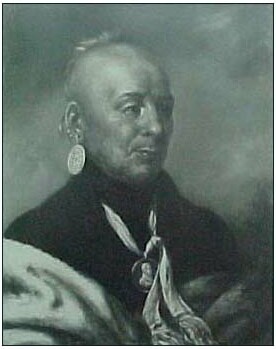Country Facts and Folklore
By Andy Reddick
Early Dawn, Chief of the Fire People
"Early Dawn" once led the "Fire
People" across southern Iowa, including a crossing of Van Buren County.
The Native Americans in this case were the
Pottawatomi tribe, and their chief at the time was Chief Waubonsie. In spite of
their explosive name, they were very peaceful.
Their settlement called Waubon near Aurora, Illinois
in the 1830s was comprised of temporary wigwams and a large main building. When
the first white settlers arrived in the area, there were 1000 squaws, papooses
and warriors residing in the village, where the tribe spent summers. They
wintered further south to the banks of the Illinois and Kankakee Rivers where
game was plentiful.
 Waubonsie
himself was a strong man, six feet four inches tall, weighing at least 200
pounds. He and his family lived in a well-constructed wigwam made of posts and
red cedar frames, 20 feet wide and 30 feet long, with a wide hallway connecting
two doors.
Waubonsie
himself was a strong man, six feet four inches tall, weighing at least 200
pounds. He and his family lived in a well-constructed wigwam made of posts and
red cedar frames, 20 feet wide and 30 feet long, with a wide hallway connecting
two doors.
Waubonsie had several wives. One son named Nequa
became a chief. The chief was known for his peaceful ways, for helping settlers,
and for detaining the bloodthirsty Sac and Fox long enough to give the whites
ample warning of danger.
He had helped negotiate the Treaty of Wabash in
1826. The Pottawatomi did not participate in the Black Hawk War, but Waubonsie
was a signer of the Treaty of Chicago in 1832. The treaty called for the removal
of Indians from Illinois to Iowa and Kansas.
Colonel Nathaniel Lyon relocated the Pottawatomi to
the area of Council Bluffs, Iowa during 1835 or 1836. It is at this time that
the tribe crossed through Van Buren County along what became known as the
Waubonsie Trail. Chief Waubonsie readied his people for the 700-mile trip. About
the spreading white settlers, he told them, "They cannot be trusted. It is
now apparent that we cannot live side by side. Our only choice now is to go
further west."
At the last minute, Waubonsie decided that he and
his family would not make the trip so Lyon accompanied the tribe and left the
leader. Eventually the chief and his family moved to Tama.
Neuqua became a favorite among the tribe and the
early settlers. He was a rival to many other young braves and was involved with
numerous disputes with settlers over the right to take Native American land.
When the Indians were ordered to move to Oklahoma, Neuqua assimilated with the
settlers for fear he would be moved.
Neuqua was a man of contrasts. He was open to new
ideas, but he held firmly to tradition, as observed by colonists who introduced
the natives to new customs. Lyon offered to teach him to plant corn and said it
was a more dependable way to make a living than hunting. Neuqua agreed to meet
with him to "learn the white way."
While Lyon was showing Neuqua how to plant the
kernels, the Indian motioned for the tribal women to come do the work, which
appalled Lyon who observed plenty of men available that could work. This
illustrates how Neuqua was willing to try new ways up to a point, but not all
the way. He was open to change, but not if they were revolutionary.
Chief Waubonsie lived to be quite old. Officially,
he was born in 1765 and died in 1848, at the age of 82 or 83, but often as he
grew older written reports added another ten years to his advancing age.
In 1835 he was more than 70 years old when he
traveled to Washington, DC with a delegation, and interviewed with President
Jackson. In 1843, the Rev. Wlliam H. Goode recorded his impressions of him,
"Wau-bon-as, a Pottawatamie Chief, said to be eighty-seven years of age,
treated with great respect by those of his tribe present; complete Indian
costume, with the skin of a cow split through the middle, through which his head
was thrust, covering his shoulders and back."
In another trip to Washington, DC Waubonsie laid the
groundwork for the Treaty of 1846, but on returning home his stagecoach
overturned and the old man suffered what would be some fatal injuries.
Along the trail crossing Iowa are many Waubonsie
parks and relic museums, which in some way pay tribute to the tribe. One of
these is in Cantril, which features a small covered bridge.
- -
Contributed to the Van Buren Co. IAGenWeb Project
by Andy Reddick
http://iagenweb.org/vanburen/
 Waubonsie
himself was a strong man, six feet four inches tall, weighing at least 200
pounds. He and his family lived in a well-constructed wigwam made of posts and
red cedar frames, 20 feet wide and 30 feet long, with a wide hallway connecting
two doors.
Waubonsie
himself was a strong man, six feet four inches tall, weighing at least 200
pounds. He and his family lived in a well-constructed wigwam made of posts and
red cedar frames, 20 feet wide and 30 feet long, with a wide hallway connecting
two doors.